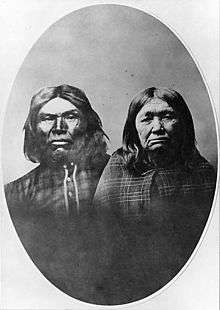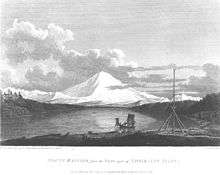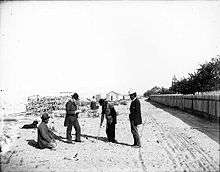Klallam
 Hicks family (Klallam) pose with canoe near Chimacum Creek, Washington, ca. 1914 | |
| Regions with significant populations | |
|---|---|
|
| |
| Languages | |
| Klallam, English | |
| Related ethnic groups | |
| other Coast Salish peoples |

Klallam (also Clallam, although the spelling with "K" is preferred in all four modern Klallam communities) refers to four related indigenous Native American/First Nations communities from the Pacific Northwest of North America. The Klallam culture is classified ethnographically and linguistically in the Coast Salish subgroup. Three Klallam bands live on the Olympic Peninsula in the far northwest corner (bordering the Strait of Juan de Fuca) of Washington state, and one is based at Becher Bay on southern Vancouver Island in British Columbia.
Name variants and usage
The indigenous Klallam language name for the tribe is nəxʷsƛ̕ay̕əm (meaning "strong people"). The word "Klallam" comes from the North Straits Salish language name for the Klallam people, [xʷstɬ̕æləm]. This has had a wide variety of English spellings including "Chalam", "Clalam", "Clallem", "Clallum", "Khalam", "Klalam", "Noodsdalum", "Nooselalum", "Noostlalum", "Tlalum", "Tlalam", "Wooselalim", "S'Klallam", "Ns'Klallam", "Klallam" and "Clallam".[1] "Clallam" was used by the Washington Territory legislature in 1854 when it created Clallam County. The following year "S'klallam" was used in the Point No Point Treaty. In the following decades the simpler "Klallam" or "Clallam" predominated in the media and research literature. In 1981 "S'Klallam" was used when the United States Department of the Interior officially recognized the Lower Elwha, Jamestown, and Port Gamble (or Little Boston) tribes.
In local media today "Clallam" is used to refer to the people of Clallam County, Washington—both native and non-native. It is also used in the names of a number of non-native commercial enterprises. The spellings with 'K' are used to refer to the native peoples. The Lower Elwha tribe has adopted "Klallam" as its official spelling. The Port Gamble and Jamestown tribes have adopted "S'Klallam" as their official spelling.
History
Pre-Contact

Before the arrival of Europeans to the Pacific Northwest the territory inhabited by the Klallam stretched across the north coast of the Olympic Peninsula from the Pacific Ocean to Puget Sound and also included the southern tip of Vancouver Island across the Strait of Juan de Fuca. Klallam villages were mostly located along the coast, while some villages were inland along rivers, inlets or large lakes.
Based on early interviews of tribal elders by early ethnologists and anthropologists, the estimated number of Klallam villages has ranged from ten to over thirty, with some ambiguity in distinguishing permanent from seasonal settlements, and some villages with mixed or disputed tribal identity.[2]
While language and tradition united the Klallam people, there were extensive trade, inter-marriage, and other forms of cooperation between the Klallam and surrounding tribes.
Culture
Transportation
The rugged terrain and dense vegetation of the Olympic Peninsula made the canoe the preferred mode of transportation. The canoes were carved from western red cedar (Thuja plicata) through an intricate and arduous process requiring great skill, beginning with the selection of the proper tree. Stone adzes, fire, and heated water were used to hollow and shape the canoe. This knowledge was passed to a select few of each generation, and some of the canoes were purchased from other tribes, especially the larger ones.
There were two main types of canoes used by the Klallam: The smaller Coast Salish type used on protected waters, and the larger Chinook style for use in rougher waters. The smaller type of canoe had a rounded bottom and was 12–30 feet (4–9 m) long, 20–48 inches (50–120 cm) wide, and 9–20 inches (20–50 cm) deep. This type was used on calm waters for fishing or to haul small loads. The larger canoes had flat bottoms and could be over 30 feet (10 m) long, 6 feet (200 cm) wide, and 3 feet (100 cm) deep. These were used on the rougher waters of Puget Sound, the Strait of Juan de Fuca, and in particular off the Pacific coast, for whaling, transporting larger loads, and carrying up to thirty passengers.
Early white settlers in the area noted the great skill the Klallam used in canoe handling and navigation, and that the Klallam canoes tended to be larger than those used by other Puget Sound tribes.[3]
Diet

The lands, rivers, marine waters, and beaches in Klallam territory provided an abundant, year-round supply of food. Strategic intertribal marriages and agreements also allowed them permission to hunt or forage outside their homeland. Though their diet included large and small land game, sea fowl, and shellfish, the most important source of food was fish. Salmon still plays a significant nutritional and spiritual role in the Klallam culture.
The Klallam fished year round using a variety of tools and techniques particular to the species, location, and season. They were known to use traps, trolling, gillnets, spears, rakes, dip nets, and holes dug in the beach. Specific locations were known to produce certain fishes at the right time of year, and special implements and skills were employed for a successful catch.
Tribal groups
- Lower Elwha Tribal Community of the Lower Elwha Reservation, Washington
- Jamestown S'Klallam Tribe of Washington
- Port Gamble Indian Community of the Port Gamble Reservation, Washington
- Scia'new First Nation (Becher Bay Indian Band), Vancouver Island, British Columbia
Schools
The Klallam tribes do not operate their own schools.
Lower Elwha Klallam children are offered a Klallam cultural and language immersion program at the Lower Elwha Klallam Head Start. Older children are provided with Klallam language and tribal history courses at Dry Creek Elementary School, Stevens Middle School and Port Angeles High School, where most Lower Elwha Klallam children attend school.
A majority of Jamestown S'Klallam children attend Sequim School District schools.
A majority of Port Gamble Klallam children attend schools in the North Kitsap School District in the Kingston area.
See also
- Tse-whit-zen, an ancient Klallam village unearthed in 2004 in Port Angeles, Washington
- Coast Salish
- Clallam (steamboat)
Notes
References
- Stauss, Joseph H. The Jamestown S'Klallam Story: Rebuilding a Northwest Coast Indian Tribe. Sequim, Washington: Jamestown S'Klallam, December 2002. ISBN 0-9723753-0-9
Further reading
- Boyd, Colleen E. 2009 “You see your culture coming out of the ground like a power”: Uncanny Encounters in Time and Space on the Northwest Coast. Ethnohistory 56(4): 699-732.
- Boyd, Colleen E. 2009 “The Indians themselves are greatly enthused”: The Wheeler-Howard Act and the Reorganization of Klallam Space. The Journal of Northwest Anthropology 43(1):3-26.
- Boyd, Colleen E. 2006 “That government man tried to poison all the Klallam Indians”: Metanarratives of History and Colonialism on the Central Northwest Coast. Ethnohistory 53(2):331-354
- Boyd, Colleen E. 2006 “Oral Traditions of the Pacific Northwest.” In American Indian Religious Traditions: an Encyclopedia, Suzanne Crawford and Dennis Kelley, eds. pp. 663–672. Santa Barbara, CA: ABC-CLIO
- Gibbs, George (1863). Alphabetical vocabularies of the Clallam and Lummi. Cramoisy Press. Available here through the Washington State Library's Classics in Washington History collection.
External links
| Wikimedia Commons has media related to Klallam. |
- Lower Elwha Klallam Tribe
- Jamestown S'Klallam Tribe
- Elaine Grinnell, Klallam storyteller and basket & drum maker
- Washington Post: "Northwest Tribe Struggles to Revive Its Language"
- Klallam language
- Thomas Charles Sr.
- S'Klallam or Klallam (Olympic National Park)
- S'Klallam Tribe
- Tribes of the Olympics
- University of Washington Libraries Digital Collections – The Pacific Northwest Olympic Peninsula Community Museum A web-based museum showcasing aspects of the rich history and culture of Washington State's Olympic Peninsula communities. Features cultural exhibits, curriculum packets and a searchable archive of over 12,000 items that includes historical photographs, audio recordings, videos, maps, diaries, reports and other documents.